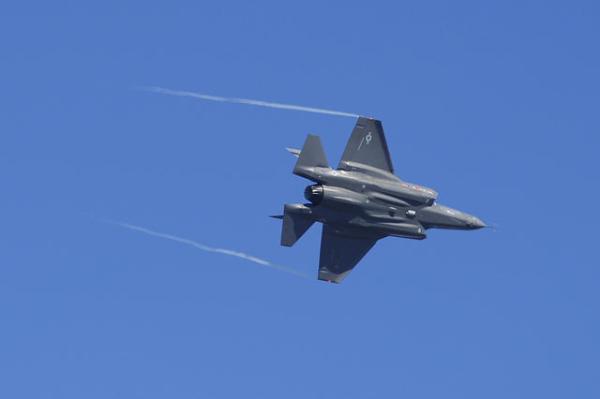The F-35 JSF Finally Has A Decent Brochure
The F-35 Lightning II Joint Strike Fighter is controversial, expensive, and troubled.
It’s also going to be the next all-in-one stealth strike aircraft for the US military and the air forces of 11 allies. So goodbye A-10, AV-8B Harrier, F-16, F-15, and F-18.
Almost a month since the entire F-35 fleet was grounded, aviation enthusiasts now have a quick and informative guide to the F-35 program right at their fingertips courtesy of DefenceIQ, a market research and news source for the global defense industry.
DefenceIQ is run by an events organizer and consultancy firm called IQPC.
Titled F-35: The Complete Guide to the Joint Strike Fighter, the 21-page report compiles everything that’s publicly known about the JSF in a single e-booklet. But there’s a catch: Only registered DefenceIQ users can download it. Registration is free anyway, so it’s no hassle.
The report’s unnamed authors succeed at getting down the basics of the JSF. There’s even a Q&A with the US Air Force’s JSF overseer Lt. Gen. Christopher E. Bogdan discussing the F-35’s foreign partners.
The report begins with a convenient timeline tracing the F-35’s inception during the mid-90s until the F-35A’s maiden test flight on February 25, 2011 and its non-appearance at this year’s prestigious Farnborough Air Show.
Pages 5 to 8 offer illustrations of the variants. The F-35 Lightning II, a.k.a. the JSF, comes in three models.
The US Air Force want 1,763 conventional F-35A’s by 2037.
The Marine Corps want 300 VTOL F-35B’s and an additional 80 F-35C’s for their amphibious assault ships.
The US Navy want 260 of the carrier-based F-35C.
Broken Down
The ensuing pages 9 to 15 summarize the F-35’s fabled technology although details about its smart helmet are absent. Unmentioned are over 1,000 companies that build its parts.
They include leading firms like Pratt & Whitney, BAE Systems, Honeywell, Elbit Systems, Rockwell Collins, Magellan Aerospace, MBDA, Raytheon, Marand, and Northrop Grumman.

via Lockheed Martin.
“It’s going to be late, it’s going to be more expensive than we thought to do the development, but it’s still going to be there, which I think that’s the ultimate metric.”—Tom Burbage on the F-35, 3-29-2013, former Lockheed Martin Executive Vice President
Those familiar with the twists and turns of the F-35 drama, however, might find this latest publication a mildly diverting brochure to promote the aircraft.
The F-35 needs the boost after years of abuse from critics like David Axe, Carlo Kopp, Chris Mills, Peter Goon, Winslow Wheeler, J. Michael Gilmore, and Jed Babbin who have written volumes about the F-35’s flaws.
These detractors have valid points. Most dire is the fifth generation F-35, on paper, appears evenly matched against fourth generation rivals like the Su-27 and the Saab Gripen. Worse, the F-35 JSF really does carry fewer weapons, with a single 25mm GAU cannon, two missiles, and two guided bombs.
Despite the clamor for redress over the F-35’s shortcomings, the program has been shopped to US allies. Page 15 breaks down the future operators of the F-35, with the majority hankering for the F-35A model.
|
Country |
Numbers Ordered |
| UK | 138 F-35B |
| Italy | 60 F-35A + 30 F-35B |
| The Netherlands | 37 F-35A |
| Turkey | 100 F-35A |
| Australia | 72 F-35A |
| Norway | 52 F-35A |
| Denmark | 50 F-35A |
| Canada | 65 F-35A |
| Israel | 19 F-35A |
| Japan | 42 F-35A |
| South Korea | 40 F-35A |
Total Foreign Orders: 705
Total F-35 Orders (US+International): 3,148
In fairness, page 16 does assess the pros and cons of the F-35…and there are more entries in the latter category.
While Lt. Gen. Bogdan gets a little mileage, it’s a dated interview from 2013 about why Norway was ordering 52 F-35A’s worth billions of dollars.
It seems no matter the noise, the F-35 is taking to the skies soon. Yet not too soon though. Hype and spin can’t dispel the inconvenient truth that it’s behind schedule and, again, expensive. (Having foreign buyers helps offset its domestic costs in the US.)
Surprisingly there is no fixed price for a single F-35. Depending on the model, it varies between a low $80 million estimate to a staggering $160 million per plane.
The total cost of the entire F-35 JSF program is over $1.2 trillion.
No wonder it’s so divisive.














Trackbacks
Comments are closed.